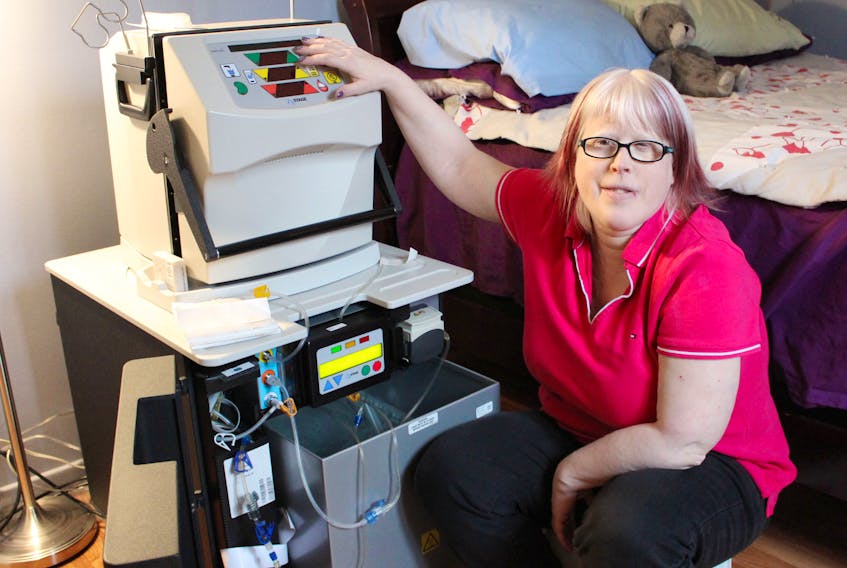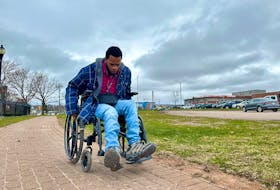Don’t ever tell Sheena King she can’t do something.
Some people have doubted her throughout her life, which has seen her have a variety of health issues, including Crohn’s disease and being declared legally blind, which many believed would exclude her from what has become a godsend for her in recent years.
Crohn’s disease caused her to have severe dehydration following a pair of surgeries in 2007. Because of this she developed kidney troubles that progressively got worse over the next seven years.
In 2014, her doctor informed her that her kidney function had been reduced to less than five per cent and she would have to start dialysis.
She had her first treatment on July 22, 2014.
“The first one was horrible. I guess I was in denial and certainly didn’t want to do it,” King said.
“I settled in after that and I started to feel better once I got on routine treatments. I then started to go to the Waterford for treatments three days a week, three hours at a time,” she added.
For the next year she took the dialysis treatments to clean her blood, and she started to feel better than she ever had.
During her time at the clinic, she had discussions with the nursing staff about the NxStage machine and home dialysis.
She was intrigued at the possibility of doing her treatments at home, so she decided to see if she was eligible. After some research, she was told she wouldn’t be eligible.
“The program had parameters and because both my husband and I are visually impaired, they told us we wouldn’t be eligible,” she said.
“I wasn’t raised to say I can’t do it.”
This is where her resilience, and some would say stubbornness, kicked in.
“I asked them to give me a shot to pass on my own merits. They said OK and basically brought me in to prove I couldn’t do it. Six weeks later I brought the machine home.”
She said it was a big commitment for her and her husband to set up the machine, learn how to use it and learn how to maintain it, with all the components that come with it.
But her gusto for life and wanting to be as healthy and normal as her ailments would allow only made her work all the harder to ensure she gave herself the best care possible.
‘No comparison’
King, who has had both in-clinic treatments and home dialysis through the NxStage system, said the home-based treatment is much better, or at least it is for her.
“There is no comparison, fantastic really,” she said.
“The treatments are gentler, easier on me for sure. Unless you have done both, you wouldn’t know the difference. The cleaning is gentler and if you have to take fluid off, you don’t feel as bad when you are done,” she added.
Hemodialysis involves accessing your blood through an access site, usually a port located in the lower arm, but can also be employed in the upper chest or leg.
The dialysis procedure involves cleaning the blood through a special filter on a dialysis machine. The main difference between home hemodialysis and in-centre hemodialysis is that instead of having a nurse or doctor help a patient with the treatment, the patient does it.
During the day, treatments are performed with or without a care partner. Treatments can be performed overnight as a patient and care partner sleep. A care partner is not a medical professional, and can be a friend, spouse, colleague or family member.
Many people who do hemodialysis at home perform their treatments more frequently for shorter periods, some even as often as seven days a week.
The best part for King is that she can now travel and still treat herself while away. In fact, she left on Tuesday morning for a pre-Christmas vacation with her family in Ontario.
All she had to do was pack her machine in its travelling kit and get it to the airport. NxStage sends the supplies she has pre-designated for her trip and the rest is just as it would be in the confines of her own surroundings, which studies have shown are better for a patient than most clinical settings.
She was even able to travel to Las Vegas recently, a trip that would not have been possible without this hemodialysis system. She also got to go home for an extended stay in Labrador, where she is from.
“It is life-changing,” she says.
NxStage dialysis at home
System One is a portable hemodialysis system designed for home use and is a more convenient way of receiving hemodialysis.
Instead of patients having to go to a dialysis centre three times a week for treatments, home hemodialysis offers the convenience of treatments in the comfort of there own home.
Its advantages are:
- NxStage’s System One has a simple user interface that is easy to understand and use.
- A standard electrical outlet and a faucet or an under-the-sink connection are all that are required to operate the System One.
- An easy-to-use drop-in cartridge allows for easy wipe-down after each use.
- 24/7 technical support gives patients peace of mind that they can get the help they need, whenever they need it.
- System One is the first and only device cleared for home nocturnal hemodialysis that allows patients to reclaim their life by treating during the day or while they sleep.
- Option to use bagged dialysate or the PureFlow SL system that prepares dialysate from drinking-quality tap water.
- System One’s lightweight portability gives patients the freedom to dialyze anywhere they want — in any room of their home or anywhere they want to travel.









